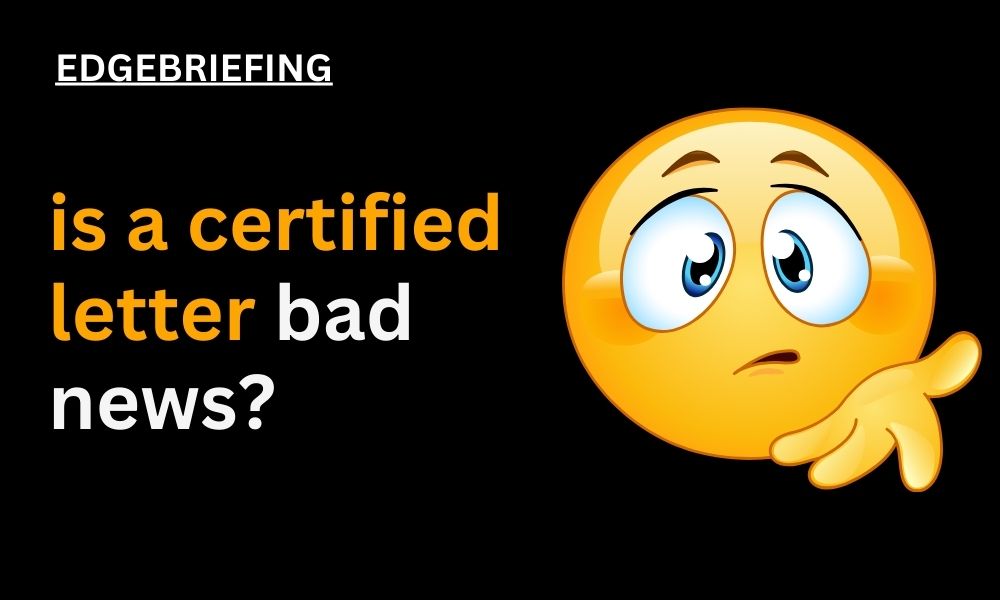Introduction
Certified letters are often seen as formal, legal communications sent through postal services to ensure receipt by the intended recipient. While these letters are commonly used for a range of reasons, including important notifications, legal matters, and business communications, their arrival can sometimes cause anxiety. The question many people ask when they receive a certified letter is whether it’s bad news.
In this article, we will explore the nature of certified letters, the types of situations that might require their use, and whether receiving one should be considered a cause for concern. Understanding the purpose behind certified mail can help alleviate some of the stress and uncertainty that often accompanies it.
What is a Certified Letter?
A certified letter is a type of mail that provides proof of delivery. It is sent through the postal system with a tracking number, ensuring that the recipient signs for it upon receipt. This method of delivery is often used for important documents or notifications that require confirmation of receipt, such as legal notices, contracts, or time-sensitive communications.
Why Do People Use Certified Letters?
Certified letters are commonly used when the sender needs to confirm that the recipient has received and acknowledged the letter. This service provides legal proof of delivery, which can be essential in disputes, contracts, or when a time-sensitive response is required. For businesses, legal entities, and government institutions, certified letters ensure accountability and maintain a record of important communications.
Is a Certified Letter Always Bad News?
A certified letter is not always an indication of bad news. While the formal and sometimes ominous nature of a certified letter can lead to anxiety, its purpose is to ensure important messages are received and acknowledged. Certified letters can carry a variety of content, including legal notices, financial statements, or even invitations to events. Therefore, the letter’s content is more important than the delivery method in determining whether the news is good or bad.
How to Determine the Content of a Certified Letter
The only way to know the exact content of a certified letter is to open it. However, there are some clues you can look for before you sign for it. If the letter comes from a known sender, such as a government agency or a financial institution, the nature of the letter may be more predictable. In general, avoid jumping to conclusions until you’ve had a chance to read the letter fully and understand the message.
Common Situations Involving Certified Letters That Could Be Bad News
Certified letters are often used in legal or financial contexts, where the news may not be favorable. For example, they may be used to notify someone of a lawsuit, an overdue payment, a foreclosure, or a tax audit. Additionally, certified letters can be used for official warnings or penalties. While these types of communications are often serious, they are not necessarily always bad news but may require urgent attention or action.
What Should You Do If You Receive a Certified Letter?
When you receive a certified letter, the first step is to accept it from the postal carrier, who will ask for a signature. Afterward, open the letter as soon as possible to determine its contents. If the letter is from a known organization, such as a bank or a government agency, it may be helpful to research the sender’s name or the reason for the certified mail. If you’re unsure about the letter’s contents or if it involves legal matters, consider consulting a professional, such as a lawyer, for advice.
Can a Certified Letter be Positive News?
Yes, certified letters can also bring good news. For instance, they may contain information about a job offer, an official invitation, an award, or a financial bonus. Many businesses and organizations use certified mail for important announcements or to confirm agreements. Though it’s often associated with legal matters, the content of a certified letter can be entirely positive depending on the circumstances.
How to Handle Stress or Anxiety Around Certified Letters
Receiving a certified letter can trigger feelings of anxiety or stress, especially if the sender is unknown or the content is unclear. To manage this anxiety, it is important to remind yourself that not all certified letters contain bad news. Try to stay calm and read the letter thoroughly to understand the situation. If you’re feeling overwhelmed, seek help from a trusted individual or professional to assess the content of the letter and decide on the next steps.
Alternatives to Certified Letters and Their Implications
Certified mail is a unique service, but there are alternatives to ensure that a recipient receives important correspondence. Registered mail provides similar security and tracking features, while express mail offers fast delivery and confirmation. Each alternative has its own costs and delivery guarantees, but none of them should be automatically considered a negative sign. The choice of mail method typically depends on the urgency or legal requirements of the sender.
Conclusion
Certified letters are a vital tool in communication, particularly for legal, financial, and official matters. While their arrival can sometimes create anxiety, they are not inherently bad news. Understanding the purpose behind certified letters, staying calm, and reading the content carefully will help ease any uncertainty. Whether the news is positive or negative, handling certified mail with clarity and action is essential.

